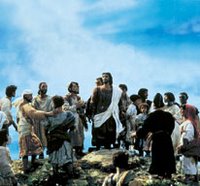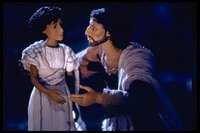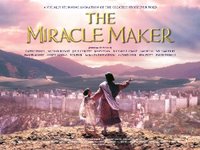Background to The Miracle Maker

Back in 2000-01 when The Miracle Maker first got released on VHS I managed to get hold of some form of special edition which also came with a novelized version of the book aimed at children. I always meant to read it and now that my own children are about the right age for it we recently sat down to read it together.
Like most such books most of the dialogue comes straight from the script and the more descriptive passages are based solely on what we see on screen. However there are a few parts of the book, particularly in its second quarter, where the writer (Sally Humble-Jackson) adds a little flavour of her own.
It's hard to know how authoritatively we should take such comments. Is Humble-Jackson fleshing out aspects of Murray Watts' original vision, or just using her own creative license? Nevertheless, as this is one film I've written quite a lot about I thought I would include a few aspects as interesting background.
The one character whose story is enhanced here out more than any other is Matthew the Tax Collector, and Humble-Jackson provides most of the extra detail in Chapter 4, where Jesus calls Peter and Matthew either side of the miraculous catch of fish. The scene takes place at the port-side where Matthew is collecting taxes from those who pass, both Peter and his fellow fishermen and Mary Magdalene. Here are some of the excerpts from the start of the scene, before Jesus has encourage Peter to put his boat out again:
The tax collectors had once been ordinary Jews, until the Romans gave them a job. Now they were seen as scum...Later Jesus begins to preach and catches Matthew's eye. "The tax collector's heart missed a beat. No-one ever met his eye". Then we're given this description:
...Matthew, the tax collector, sighed. She'd crossed the border so she had to pay [Magdalene]. It wasn't his fault - he didn't make the rules...
...Matthew flinched. Was he to blame if the nets came up empty? 'It's the law' he tried to explain, over the din of the mad woman.
Matthew looked uneasily at the flimsy roof of his tax-booth. One day an angry fisherman was going to knock it to the ground. He imagined himself flying to the safety of a tree, high in the branches where nothing could hurt him. And then he closed his eyes and sighed. Who'd want him in their tree? No-one...Finally we come to Matthew's appointment.
Even from so far away Jesus could see the glitter of tears.
How he wished he'd never become a tax collector. Then he might have been able to look Jesus in the eye...Matthew began to shake. More insults, more anger.Now none of this goes against the scenes we see in the film, but it certainly offers more than is the film itself. And it's a really interesting exploration of the character's inner journey at this point.
'Matthew,' called Jesus again, 'follow me!'
Baffled, Matthew lifted his head. He looked Jesus in the eye. And what he saw there filled his heart with longing. All the things he'd done wrong...they didn't matter any more. His sins had been forgiven! Slowly he got to his feet. With trembling hands he threw down his money and went to Jesus' side.
Matthew? The tax collector? The others were shocked - but when they saw the love in Jesus' eyes they felt ashamed of themselves.
There's one other section that stood out for me, from the next chapter (five) concerning the extra-biblical villain Ben-Azra. Ben Azra is brought in to play a similar role to Zerah in Jesus of Nazareth (1977) and Livio in Jesus (1999) - the extra-biblical authority figure pulling all the strings in the background. And there's a little insight into his character as well:
Ben Azra, for instance, had grown rich and powerful by helping the Romans keep the peace. He thought the people would tire of this magician from Nazareth, but as the months passed, the crowds just got biggerThe detail about how Ben Azra had gained his wealth is a step beyond what we get from the film, though it's certainly a very reasonable step. It also contrasts with the above description of Matthew whose wealth had also come because he had sided with the Romans
Labels: Miracle Maker


















































